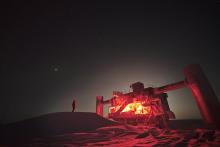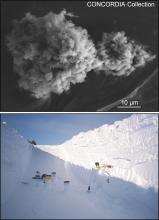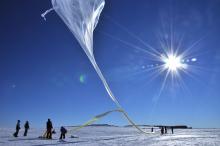Listen to today's episode of StarDate on the web the same day it airs in high-quality streaming audio without any extra ads or announcements. Choose a $8 one-month pass, or listen every day for a year for just $30.
You are here
Hunting Space Rocks
Mount Cecily and Mount Raymond are two fairly unremarkable peaks in the Grosvenor Mountains of Antarctica. But something remarkable litters the ice at their bases: rocks from outer space. In fact, a team of scientists will be spending the next couple of months there, gathering up the meteorites for later study. At the same time, another group will be looking for meteorites on an ice field a few hundred miles away.
The scientists are part of ANSMET — the Antarctic Search for Meteorites. It’s been sending teams to the Antarctic for more than 40 years. They’ve gathered more than 22,000 meteorites. Most are chips off the surfaces of asteroids. But many are pieces of the Moon and the planet Mars.
Antarctica is a good site to hunt for these rocks for a couple of reasons. First, out on the open ice there are very few Earth rocks. That means there’s a good chance that any rocks sitting on the surface came from space.
And second, the bases of mountains can expose meteorites that have been on Earth for a long time. As glaciers flow toward the edge of the continent, they ram into mountain ranges. Layers of ice that have been buried for thousands of years can be pushed to the surface. Strong, dry winds vaporize much of the ice, exposing rocks that had been entombed in the ice — including a high concentration of meteorites. In fact, that’s what makes the Grosvenor Mountains a good spot for hunting for rocks from beyond Earth.
More about the search tomorrow.
Script by Damond Benningfield






